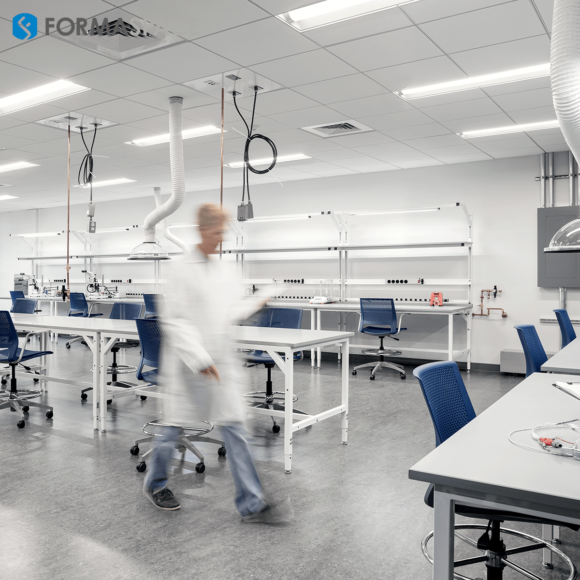Advances in laboratory research keep accelerating with new techniques and technologies changing the way laboratory researchers perform experiments and make discoveries. These changes have made it more important than ever for lab architects and lab managers to keep flexibility in mind when planning new laboratory construction or renovations.
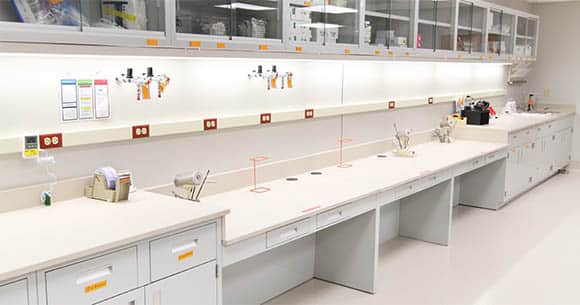
Major advances in the capabilities of scientific lab equipment, digital computing, and experimental research methods and techniques have had a significant impact on the physical design, layout, and safety considerations for lab safety and design. As a result, modern laboratory design has to be flexible and functional to keep up.
This applies to both of the two traditional lab design categories: Wet Labs and Dry Labs.
Wet Lab Design Considerations
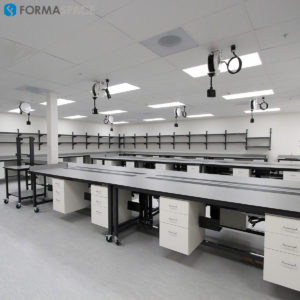
Even though scientific equipment has advanced, the importance of wet labs has not fundamentally changed. These types of labs handle a range of biological specimens, chemicals, drugs, and other materials for use in experiments. In order to support scientific research effectively and safely, wet labs need a range of tools, equipment, and services at hand, such as:
- Lab bench countertops and sinks which can be cleaned easily and are resistant to bacteria and chemicals
- Piped in hot and cold water, often including reverse osmosis (RO) or deionized water
- Chemical fume hoods and biosafety cabinets (BSCs)
- Facilities for handling live test specimens (animal housing aka vivariums) or proximity to clinics for human subjects
- Specialized refrigerators and freezers for storing tissue and other specimens
- Controlled environment areas (warm or cold rooms)
- Autoclaves and other sterilization equipment
- Glass washing and drying area
- Piped in compressed air and vacuum as well as a range of other gasses like natural gas, oxygen, etc.
- Radioactive work area for radiological materials, including safe storage facilities
- Safety showers, eye wash stations, and hand washing stations
- Climate control of ambient air and ventilation (HVAC)
- Vibration controls for sensitive experiments, such as DNA sequencing.
- Drain, Waste, and Vent (DWV) services
Dry Lab Design Considerations

As computers and digital instruments have become more and more central to scientific research, the role of most dry labs has expanded from providing a space for working with dry stored chemicals to a lab space populated with a network of powerful computing systems. There is a light-hearted description for this shift toward computer-based research: while wet labs (working with chemicals and live specimens) make discoveries in vitro, the dry lab discoveries are made in silica using computer software.
Dry laboratory spaces will have fewer requirements for piped services than wet labs. But that doesn’t mean they don’t have their own unique requirements. Increasingly, dry labs need these types of services:
- Extensive cooling and humidity controls to support computer labs (HVAC)
- Clean power systems for sensitive computers, research instruments, and network communications
- Occassional clean room system installations are required for certain processes and experiments
- Vibration controls for sensitive instruments that need to maintain calibration
- Fire suppression systems
What Kinds of Scientific Activities Take Place in Modern Research Laboratories?
To help visualize the different types of activities taking place in wet labs versus dry labs, here is a breakdown of the different types of activities taking place in each one:
Wet Lab Examples
Biomedical Laboratories
- Anaerobic Chamber Labs
- Cell Biology Labs
- Fermenter Labs
- Molecular Biology Labs
- Pathology Labs
- Tissue Culture Labs
Chemistry Laboratories
- Organic Chemistry Labs
- Physical Chemistry Labs
Dry Lab Examples
(Note: samples for study are often prepared in adjacent wet labs)
Instrument and Special Function Labs
- Computer Labs (Mainframe, Workstation, and PCs)
- Confocal Microscope Labs
- Electromagnetic Instrument Labs
- Electron Microscope (EM) Labs
- Electrophysiology and Biophysics Labs
- Flow Cytometry Labs
- Laser Labs
- Mass Spectrophotometry (MS) Labs
- Robotic Equipment Labs
- X-Ray Crystallography Labs
Do’s and Don’ts of Good Laboratory Design Planning
1. Do Remain Flexible
Given the rate of change in laboratory technology and the rapid expanse into new areas of scientific research, it’s critical to maintain flexibility in your choice of furniture. Modular furniture allows you to re-configure your laboratory layout easily to accommodate new usages.
2. Don’t Rely on Fixed Casework Alone
Fixed casework has the traditional solution for many laboratories but making any changes requires a significant investment in new construction along with long downtime periods. Limit casework usage to where it’s required, such as matching existing legacy installations.
3. Do use a Modular Design Philosophy
For large facilities that incorporate multiple laboratory units, a modular design philosophy — based on a set of standard laboratory ‘building blocks’ — provides maximum flexibility for the future. Modular design allows individual units to be reconfigured without affecting the other labs.
4. Don’t use the wrong materials in Countertops and Lab Benches
Formaspace Design Consultants will steer you to the right choice in modern materials for your laboratory. For wet lab applications, you want to choose chemically-resistant countertop surfaces for laboratory benches that are easy to clean and resistant to bacterial growth and corrosion. In cleanroom labs, stainless steel, and heavy-duty plastic laminate can be the right choice. In electronic labs where sensitive equipment is being assembled or serviced, surfaces with built-in electric discharge capabilities will protect your expensive gear from accidental damage from static shocks.
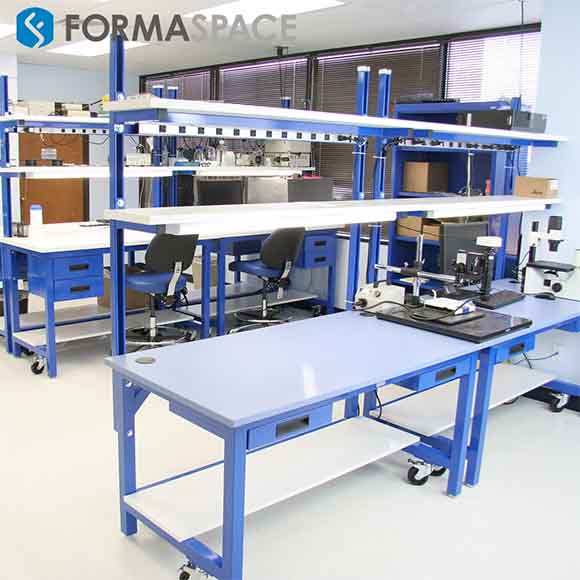
Consider These Laboratory Safety Guidelines as Part of Your Good Laboratory Practices (GLP)
Keep in mind the importance of laboratory safety guidelines when designing your wet and dry lab facilities.
1. Do design electric systems carefully to prevent accidental shock
Make sure you take into consideration the potential for accidental leaks and inadvertent flooding when designing your electrical system. Evaluate if you have isolated key electrical systems and test shut-off safety systems on a regular basis.
2. Don’t let the storage facility become an ad hoc laboratory
Be aware of the tendency for storage spaces to become a temporary place for laboratory experiment that end up becoming permanent. Unless the storage space has fire suppression, sufficient egress, ventilation, and emergency lighting, it’s not safe to be used this way. Be smart and stay safe.
3. Do add toxic gas monitors to your facility
Even small amounts of dangerous colorless gasses like hydrochloric acid can be fatal when breathed in by laboratory personnel. Install toxic gas monitors throughout your facility to alert staff of dangerous conditions with both visual strobe and audible alerts inside and outside the facility.
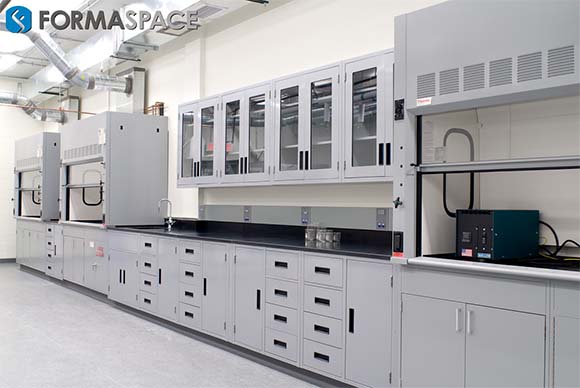
4. Don’t skimp on safety equipment like eyewash stations and showers
Accidental exposure to chemicals and other substances can happen quickly and unexpectedly. Be sure to provide convenient eyewash stations and deluge showers to protect lab personnel in case of an accident.
5. Do plan out your experiments in advance and take note of your safety equipment before you start
It’s an important mental exercise to run through your entire experiment in your head before proceeding. Do you have all the safety equipment at hand? Are all your tools, glassware, hand and facial protection gear at hand for the initial steps as well as the follow-up steps? If you prepare mentally before starting, you’ll be better equipped to react to something unexpected happening.
6. Don’t litter in your own laboratory
We are all under pressure to do more with less time, but taking shortcuts can be a safety hazard. Don’t try to eat or drink in the laboratory. Pay attention to sharp items (like pipettes, scalpels, needles, and broken glassware). Keep glassware clean and organized. Clean up spills and report them if they are potentially hazardous. Time spent keeping your laboratory clean and organized is time well spent, as it will help reduce accidents and ruined tests.
Make it your Good Laboratory Practice (GLP) to Call on Formaspace
Whether you are designing a new facility or renovating an existing laboratory, our Formaspace Design Consultants have years of experience helping lab managers and architects create state-of-the-art laboratory facilities.
Take advantage of our expertise.
We’ve helped clients like Roche, Schlumberger, LifeLabs, Avero, and Antech Diagnostics build out their laboratories — and we’re ready to help you next.
Contact a Formaspace Design Consultant today to get started.


